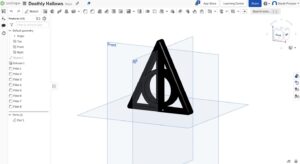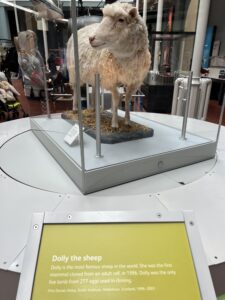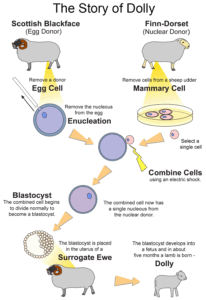
For my personal project in Scotland, I made the Deathly Hollows from Harry Potter.

Design and Innovation of Healthcare Systems
Scotland Study Abroad Program 2022

For my personal project in Scotland, I made the Deathly Hollows from Harry Potter.
Dolly the sheep was the first mammal to be cloned using biomedical engineering from an adult cell. This experiment took place at the Roslin Institute, at The University of Edinburgh. Professor Sir Ian Wilmut led the research team to clone a cell from a Finn Dorset Sheep, which proved to be successful when Dolly did not share the black markings that her surrogate mother had.
This experiment created a multitude of possibilities within biology, while also raising several questions concerned with the ethics of cloning (Roslin Institute, n.d.).
Dolly was cloned using the Somatic Cell Nuclear Transfer, or SCNT. For this, the nucleus of a somatic, body cell is transferred into the cytoplasm of an egg cell that has its nucleus removed. The nucleus from the somatic cell replaces the original nucleus from the egg cell to become a zygote (fertilized egg). With this method, extinct species could be resurrected, such as the wooly mammoth with an elephant surrogate (Stocum & Rogers, 2009).
Dolly died in 2003, but she is now located in the National Museum of Scotland in Edinburgh.
The Life of Dolly. (n.d.). Dolly the Sheep. Retrieved July 6, 2022, from https://dolly.roslin.ed.ac.uk/facts/the-life-of-dolly/index.html
Stocum, D., & Rogers, K. (2009). somatic cell nuclear transfer | Definition, Steps, Applications, & Facts. Encyclopedia Britannica. Retrieved July 6, 2022, from https://www.britannica.com/science/somatic-cell-nuclear-transfer



The Surgeon’s Hall Museum in Ediburgh was an amazing experience to see how far science and technology have improved in the past few centuries. The Museum featured a history of surgery exhibition, which, as a pre-med student, was one of my most interesting endeavors on our trip. The exhibit featured tools and techniques used in surgery over the past several centuries. Prior to this trip, I gave little thought to medical products and their innovation. I visited the museum during our last week, and it was perfect timing; I had already learned so much about biomedical engineering and design during the program, which made visiting the Museum in the last week the perfect way to cap my learning.
The tools and techniques used in the 17th century, and on, are utterly shocking to me. Surgery was performed without anesthesia, without antiseptics, and without clean tools. The Museum walked you through how surgery has evolved, from grave-robbing (which Scotland was notoriously known for) to learn the basis of human anatomy, to keyhole surgeries in the modern day. The Surgeon’s Museum was a great way to not only learn about human anatomy, but also perfect for applying biomedical engineering to healthcare. It helped me, a Biology major, learn more about how important biomedical engineering truly is for improving post-operation outcomes. I would definitely recommend visiting the museum to anyone in Edinburgh!